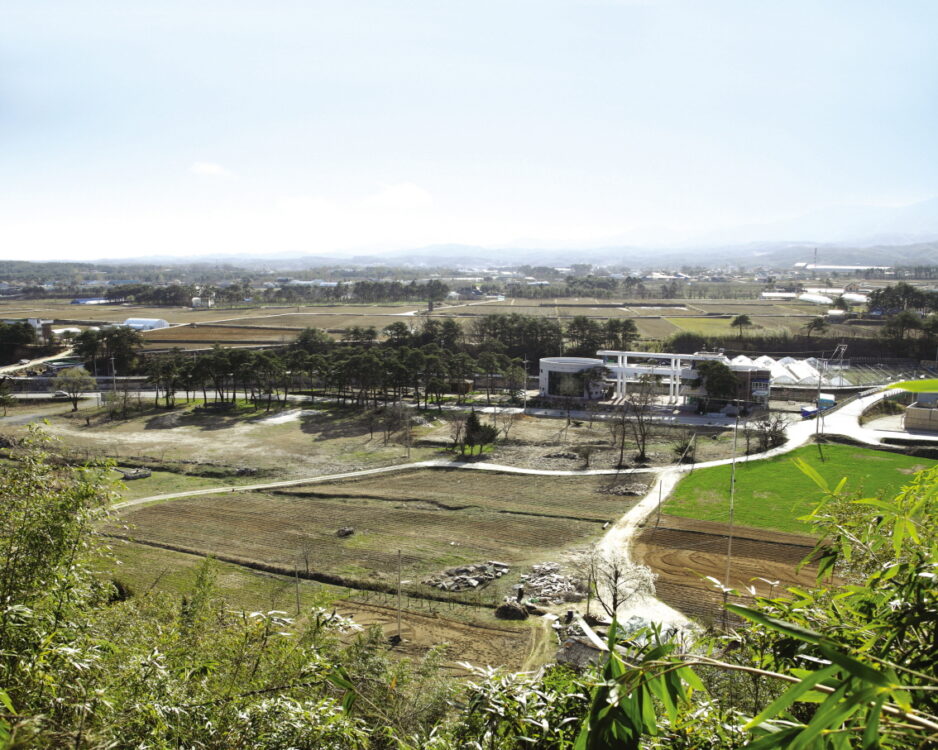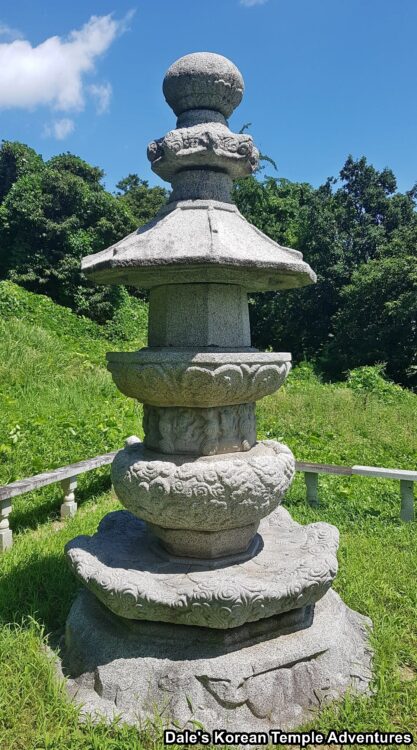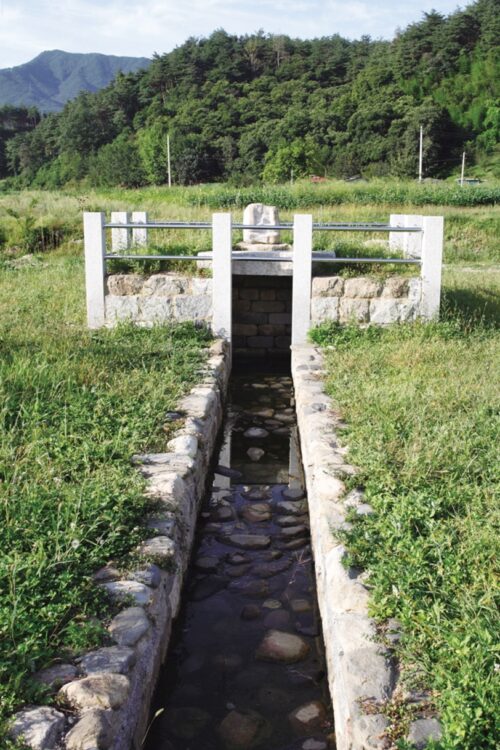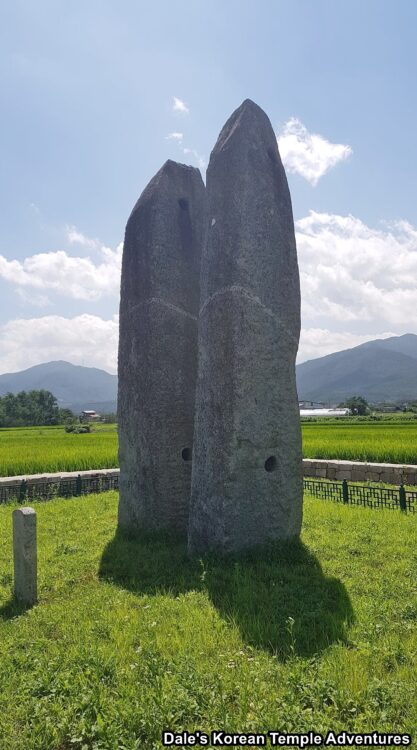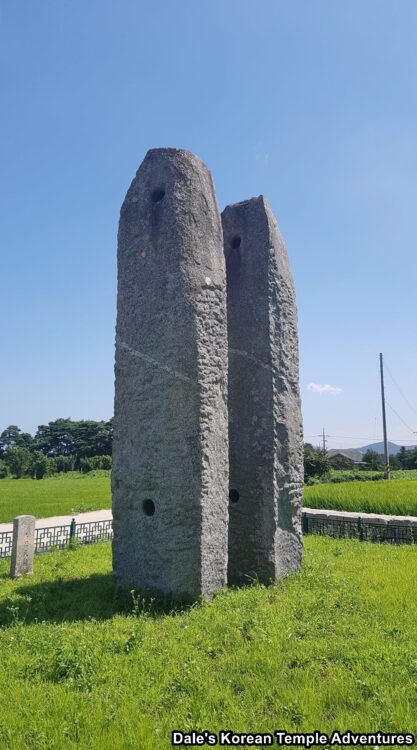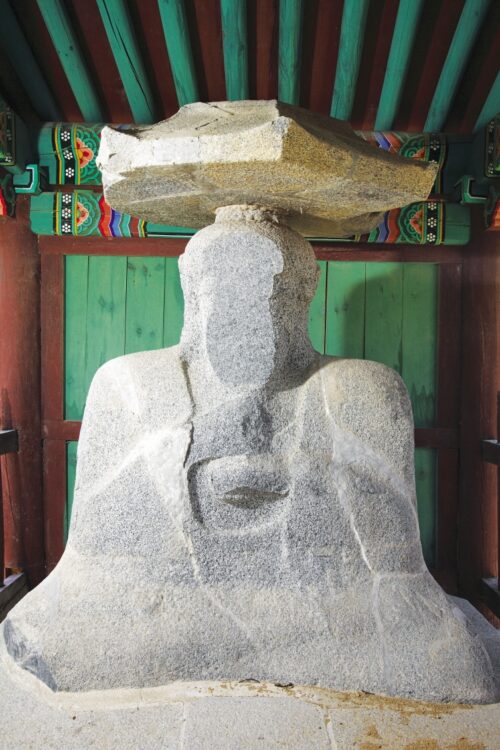Gulsansa-ji Temple Site – 굴산사지 (Gangneung, Gangwon-do)
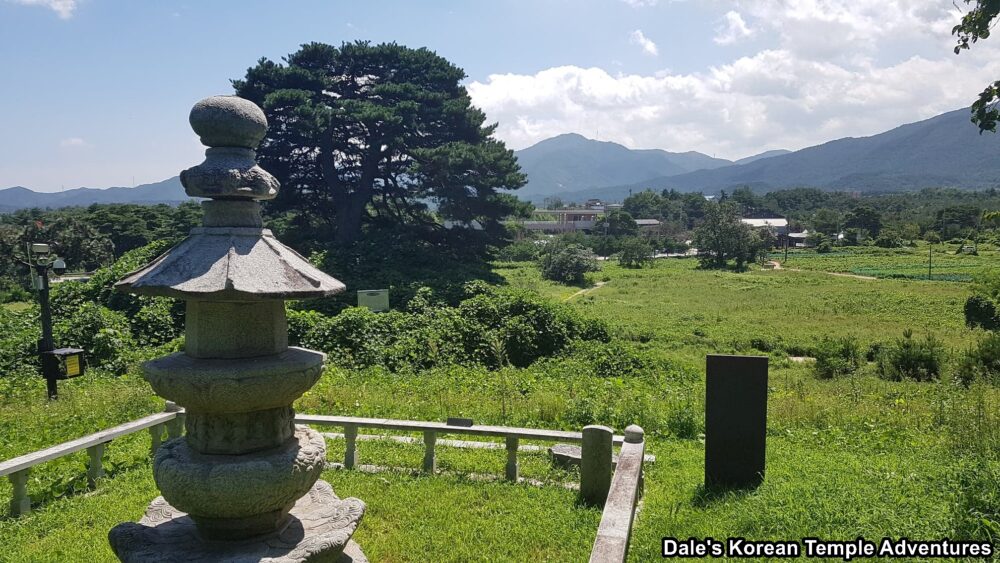
Temple Site History
The Gulsansa-ji Temple Site is located in the southern part of Gangneung, Gangwon-do in Haksan Village. The temple site occupies an impressive 66,698 m2 in size spread out over farmland, but the exact boundaries are unknown. Gulsansa Temple was first founded by National Preceptor Beomil-guksa (810-889 A.D.) in 851 A.D. The temple was one of the Nine Mountain Schools of Seon Buddhism.
Here’s a little more about Beomil-guksa. According to a legend, there was a virgin from Haksan Village. One day while drinking water from a bowl, the sun shone down on the bowl. After she drank this water, she became pregnant and eventually delivered a baby boy after fourteen months of pregnancy. But because this woman was a virgin, locals made up rumours about her. Ashamed, the woman’s parents decided to leave the newly born baby under a rock. When they re-visited this rock several days later, they found that the baby was still alive. Not only that, but the baby was in good health and being fed by cranes. Amazed by this, they decided to name the baby Beomil, and they took him home. Seokcheon Spring, which is where Beomil’s mom drank the magical water from and became pregnant, is located in the centre of Haksan Village near the Stupa at Gulsansa Temple Site. And the rock where Beomil was nourished by the cranes is located near the village.
And here’s a little more on the Nine Mountain Schools of Seon and the integral role that Gulsansa Temple played in the dissemination of meditative Buddhism throughout the Korean Peninsula. Gulsansa Temple was home to the Sagulsan sect founded by Beomil-guksa. At the time of the Nine Mountain Schools of Seon, the Sagulsan sect was the most prosperous of the nine. In 831 A.D., Beomil-guksa traveled to Tang China (618–690, 705–907 A.D.), where he received the Mind Seal from the Chan Master Yanguan Qian (750-824 A.D.). Beomil-guksa traveled extensively throughout Tang China to further his Buddhist studies. Eventually, he traveled to Mt. Caoxi, where he intended to pay his respects to Sixth Patriarch Huineng (638-713 A.D.). It was while paying his respects that he received an auspicious sign from a perfumed cloud that was hovering around the shrine that housed Huineng’s remains. Additionally, there were cranes crying above the shrine, as well. Finally, Beomil returned to the Silla Kingdom (57 B.C. – 935 A.D.) in 846 A.D., where he helped expand Gulsansa Temple, which became the base for the Sagulsan sect. In total, Beomil-guksa met three kings, which only helped further the prestige of the temple, as the kings asked him to become the national priest. Those kings were King Gyeongmun of Silla (r. 861-875), King Heongang of Silla (r. 875-886), and King Jeonggang of Silla (r. 886-887). He rebuffed all three to focus on meditation. Beomil-guksa would stay at Gulsansa Temple for the next forty years until his death. He would pass away in 889 A.D.
Gulsansa Temple would flourish thanks to local patronage during the Goryeo Dynasty (918-1392). As to when the temple fell into disrepair, it’s not specifically known. However, because Gulsansa Temple doesn’t appear in any documents after the early Joseon Dynasty (1392-1910), it’s assumed that the temple closed at this time. And to be more specific, it’s been argued by some scholars that Gulsansa Temple was closed around 1530.
During Japanese Colonial Rule (1910-1945), the temple site was known early on. And the Stupa at Gulsansa Temple Site was thoroughly researched. At this time, the stupa was designated as Treasure #127 by the Governor-General of Chōsen in 1934. However, in 1935, the stupa was partially destroyed and the relics inside it were stolen. By 1936, a flood partially damaged the temple site grounds. Later, and in 2002, flooding occurred, once more, on the temple site due to Typhoon Rusa, which led to an emergency excavation of the temple site area. This excavation revealed that from its centre, the temple stretched from 140 metres from east to west and a further 250 metres from north to south. It was also at this time that the main hall site, monks dorms’ site, corridor sites, and a pagoda site were all discovered at the Gulsansa-ji Temple Site.
The Gulsansa-ji Temple Site is home to two Korean Treasures: the Stupa at Gulsansa Temple Site, which is Korean Treasure #85; and the Flagpole Supports at Gulsansa Temple Site, which is Korean Treasure #86. The Gulsansa Temple Site is also a Historic Site. It’s also home to the Stone Seated Buddha at Gulsansa Temple Site, which is a Gangwon-do Cultural Heritage Material #38.
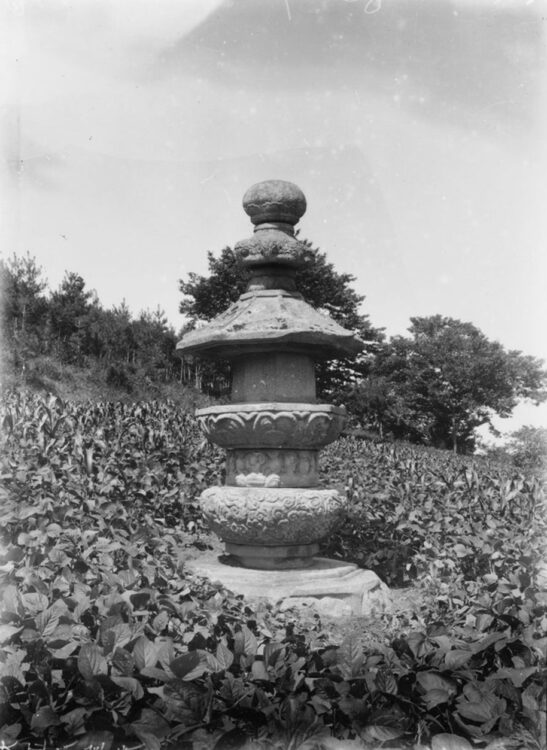
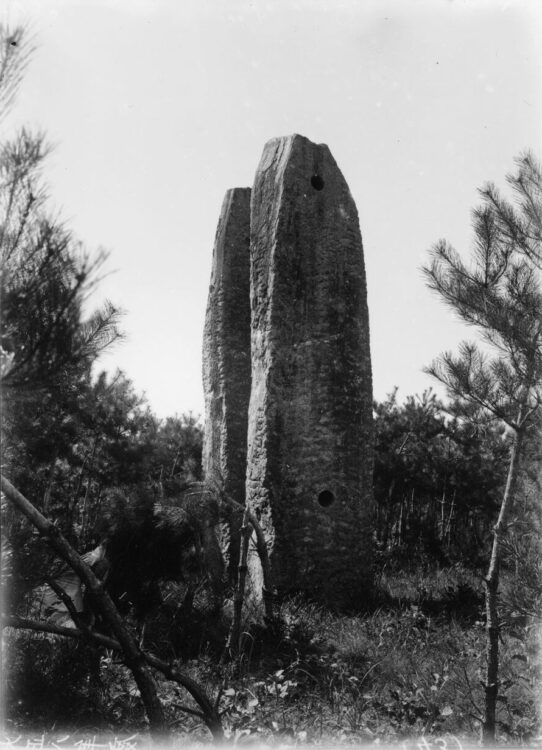
Temple Site Layout
Starting in the western part of the temple site grounds, which is now divided by the Geumpyeong-ro Road, is the Stupa at Gulsansa Temple Site. This stupa was erected to contain the sari (crystallized remains) of Beomil-guksa. It’s believed that the stupa was first erected some time during the Goryeo Dynasty. The stupa consists of three components: the base, the body (which contained the sari), and the finial with a roof stone. Overall, the stupa is octagonal in shape. The eight-sided base is adorned with various animals and a plate-shaped stone that rests upon it has cloud patterns carved onto it. Above that, and still a part of the base stone, is the top supporting stone that is engraved with lotus flowers in full bloom. Above this, and supporting the body of the stupa, is an eight-sided stone that has eight celestial images playing various instruments. These eight sides are divided by engraved stone pillars, and the musical instruments that the eight Bicheon (Flying Heavenly Deities) play include the janggu (double-headed drum), xun (Chinese globular vessel flute), dongbal (Korean cymbals), bipa (Korean lute), so (flute), saenghwang (reed instrument), gonghu (harp), jeok (large bamboo flute). The main body of the octagonal stupa is made from one core stone and a roof stone. The main body stone is rather small and the roof stone is slanted. The eaves of the roof stone are flat and do not turn upward. Additionally, the finial to the stupa has a large spherical object on top of it that looks like a lotus bud. The Stupa at Gulsansa Temple Site is Korean Treasure #85.
It’s about fifty metres to the east, but before crossing over the Geumpyeong-ro Road, that you’ll find the Seokcheon Spring from the legend surrounding the birth of Beomil-guksa. It’s not much of a spring anymore. It’s largely overgrown, and it doesn’t look as though its been used for years. But it’s there all the same to be explored and appreciated.
Having crossed over the busy road and walking for about 500 metres eastward, you’ll come across the Flagpole Supports at Gulsansa Temple Site, which were built during Unified Silla (668-935 A.D.). These flagpole supports are known as “danggan” in Korean. From these flagpole supports would float a flag (dang) at the entrance of the temple grounds. These flags were typically flown to mark a special occasion like the Buddha’s Birthday. These specific flagpole supports at the Gulsansa-ji Temple Site are the largest historic supports of their kind in Korea. The flagpole supports stand 5.4 metres in height and are separated by 1 metre of space between the two supports. These supports are unadorned and tool marks are visible near the base of the supports. You’ll notice grooves near the top and bottom of the flagpole supports, as well. These were meant to hold the flagpole in place on the supports. While unsophisticated in design, they are immense and grand in size. They are Korean Treasure #86.
Traveling about 150 metres further east, you’ll come to the Stone Seated Buddha at Gulsansa Temple Site, which is Gangwon-do Cultural Heritage Material #38. It’s hard to imagine what this statue must have once looked like because it has been so badly deformed and disfigured by the passage of time. The face and robe are hardly visible. The only things that are visible is the six-sided crown atop the statue’s head, and the mudra (ritualized hand gesture), or “suin” in Korean, that the statue is striking. This mudra helps us identify the statue as Birojana-bul (The Buddha of Cosmic Energy). It’s presumed that this statue was first constructed during the Goryeo Dynasty (918-1392). The statues sits in its own tiny pavilion to protect it from the elements.
How To Get There
From the Gangneung Intercity Bus Terminal, you can catch Bus #101 to get to the Gulsansa-ji Temple Site. The bus ride will last around 30 minutes, or 22 stops. You’ll need to get off at the “Haksan 2-ri Maeul Hoegwan – 학산2리마을회관” stop. And depending on which part of the temple site you want to explore first, you can either head west for about 250 metres to get to the Stupa at Gulsansa Temple Site, or you can head east from the bus stop for about 500 metres to get to the Flagpole Supports at Gulsansa Temple Site.
Overall Rating: 3/10
It’s almost impossible to try to imagine what the Gulsansa-ji Temple Site must have once looked like at its zenith as a temple, but it’s nice to wonder all the same. As for its current state, it’s the beautiful Stupa at Gulsansa Temple Site that’s the main highlight at the temple site. But the entire temple site can and should be appreciated, so make sure you also visit the Flagpole Supports at Gulsansa Temple Site and the Stone Seated Buddha at Gulsansa Temple Site through the labyrinth of back country roads that run alongside the farmers’ fields.
